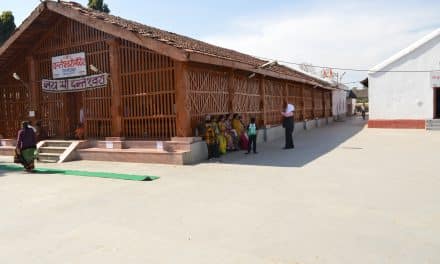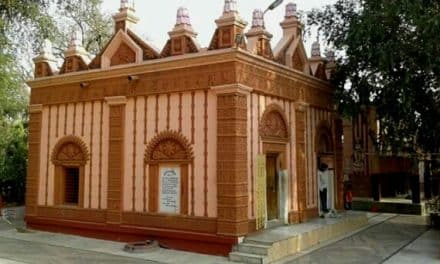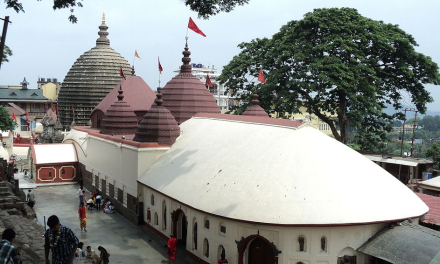Kalighat Kali temple is one of the most famous landmarks of eastern India. The term Kalighat came from the Hindu goddess Kali who resides in the Temple, and Ghat (riverbank), where the Temple is located. Some sources claim that the name ‘Kolkata’ has been plucked from the word ‘Kalikata’ Devi of Kalighat Temple. This Temple was symbolised as one of the fifty-one Shakti Peethas(divine seats of Shakti or Primordial Mother Goddess) where it was supposed the toes of the right foot of Devi Dakshayani or Sati fell during Shiva’s Rudra Tandava(rampage or the dance of destruction) mentioned in the Hindu Scriptures. However, some Puranas also mention that the ‘Mukha Khanda'(face) of Sati fell here, got fossilised, and was stored and worshipped here.
Historical references behind the emergence of the Temple
Though it is hard to say the exact date the Temple was established, the inscription of the Kali temple of Kalighat was in ‘Mansar Bhasan’ in the 15th century and also in Kavi Kankan Mukunda Das’s ‘Chandi Mangal’ in the 17th century. On the other hand, it was composed in ‘Sambanda Nirnay’ by Lalmohon Bidyanidhis’s. It is said that the Temple was a classic example of Bengal architecture which is a structural emulation of the mud and thatch-roofed huts of villages and was founded by one pious saint Chouranga Giri(a Dasanami Monk and after whom the most famous and fashionable part of Kolkata, Chowranghee area is named) as a small structure. On the contrary, it had recorded as the original Temple was a small structure constructed by King Mansingha in the early 16th century.
There is a parallel record conserved in history as the original Temple was sited on the banks of the river Hooghly(Adi Ganga), set up by Raja Basanta Roy, the uncle of Pratapaditya and the king of Jessore(presently in Bangladesh). In around 1570, Padmabati Devi, the mother of Lakshmikanta Roy Chowdhury of Sabarna Roy Chowdhury family of Barisha, had a divine vision and discovered the right toe of Sati in a lake called Kalikunda in Kalighat. There are also several stories behind the emergence of this famed Temple. However, the present-day structure was erected by Santosh Roy Chowdhury in 1798 and was subsequently completed by his grandson Rajib Lochon Roy Chowdhury in 1809. So, this Temple’s antiquity has been accounted for over 200 years since its completion of erection. Archer-type coins of Chandragupta II, which became the most popular type of coinage with the Gupta rulers after Kumargupta I, have been found in Kalighat. It is concrete evidence of its oldness. There is a huge conflict between the Sabarna Roy Chowdhury family of Borisha and the Halder family of Kolkata to be the owner of this great ancient Temple.
About the image of goddess Kali and its antiquity
The image of Kali in this Temple is truly unique because of its unlike posture, which the others(other Kali images of Bengal) do not bear. The image of the deity appears incomplete. Initially, the face of the goddess was made, and later tongue and hands made of gold and silver, respectively, were added to the image. Deriving information from some Hindu Puranas or Texts, there was a mound in this place which was called ‘Brahmar Dhipi'(a mound familiarised with the ‘Hindu All-Father, Brahma). The talked-about image of the goddess Kali was placed on that Dhipi(mound) and had been worshipped regularly. The present idol of touchstone was created by two saints—-Atmaram Brahmachari(Giri) and Brahmananda Giri.
Presently the idol of the mother goddess Kali of Kalighat carries away three huge eyes, a long protruding tongue which is as fearsome and unique as the other images of the Kali have as well as four hands. However, the Shakti here is Dakshina Kalika(the benevolent mother of the world), while the Bhairava is Nakulesh or Nakuleshwar–the All-Father. All these organs of the Kali image are made of pure gold. Initially, the four hands of the idol were made of silver and donated by Gokulchandra Ghoshal; the Diwan of the East India Company, which had been replaced later with the precious metal of gold, was further donated by a benevolent person named Kalicharan Mullick.
Ramnarayan Sarkar Beleghata donated the crown on Devi’s head. Raja Indrachandra Singha of Paikpara bestowed the unique golden tongue, and the Maharaja of Patiala donated the garland of heads that the goddess wears. Nepal’s former Army Chief donated the Umbrella on top of the goddess’s head. Among Her four golden hands, the top left-hand holds a Kharga or a Scimitar(signifies Divine Knowledge), and the bottom left-hand holds a severed head of the Asura King Shumbha(signifies the human ego which has to be slain by the Divine Knowledge to attain ‘Moksha’ or one’s goal in life). The other two hands(top right and bottom right) are in the Abhaya(signifies the goddess is always with Her devotees, protecting them from harm) and Varada mudras(shows the benevolence and the soft-heartedness of the Devi, showering Her devotees with divine and material blessings). History tells us that the image here is based on the idol of Mata Bhubaneshwari, the Kuladevi(clan deity) of the Sabarna Roy Chowdhury family of Barisha.
The Temple, which accommodates all its deities and other erections
Shoshti Tala: An alter shaped in a rectangular platform which is three feet high, situated beneath a small cactus plant, adorned with three stone structures side-by-side, left to right regarded as the goddesses ‘Sashthi’, ‘Shitala’ and ‘Mangal Chandi’ and worshipped as a part of Goddess Kali herself. This remarkable alter was erected by Gobinda Das Mandol in 1880, also known as ‘Manosha Tala’. It is a belief that this spot is the tomb of Brahmananda Giri. It is a wonder that all the priests who confer their devotions to the mentioned three impersonations of Goddess Kali belong to the female gender and practise the ritual with no daily worship or food offering.
Natmandir: Another rectangular verandah(portico) called ‘Natmandir'(one of the buildings of the Temple, especially in the Kalinga architecture) has been set up adjacent to the main Temple (particularly to the ‘Garbha Griha’, that is to say, Sanctum sanctorum) is in the southern wing from where the face of the image is visible. Additionally, rituals being practised inside the ‘Sanctum Sanctorium’ are distinctly visible from the ‘Natmandir’. This erection was established by the landlord Kashinath Roy in 1835. Sometimes renovation of this erection takes place.
Jor Bangla: The platform or the spacious verandah(portico) of the main Temple, right outside the Sanctum Sanctorum and facing the image, is known as ‘Jor Bangla'(also a bathing ghat of the main Temple). The rituals performed inside the Sanctum Sanctorum are visible from this platform apart from ‘Natmandir’.
Harkath Tala: This is the spot adjoining the Natmandir (particularly towards the southern side) utilised for ‘Bali'(sacrifice). The site contains, in total, two wooden sacrificial alters for animal sacrifices side-by-side. One of the two, the bigger one, is utilised for sacrificing bigger animals like buffaloes, and the other smaller one, is used for sacrificing the smaller animals like goats and sheep, which are slew with a single stroke of a scimitar. These come into being as ‘Hari-Kath’.
Radha-Krishna Temple: It is located inside the temple premises, particularly on the main Temple’s west side. Initially, it was erected by a settlement officer of Murshidabad district in 1723. The Temple was established by a Zamindar named Uday Narayan Mandol of Bhaowali in the same spot in the year 1843. The Dolmancha(a typical permanent structure in many parts of Bengal built specifically to celebrate the festival of colours) was founded by Madan Koley of Saha Nagar in 1858. Different cuisine is allotted for the preparation of vegetarian Bhog for Radha-Krishna.
Kundapukur: It is believed that the ‘Kundapukur is the sacred tank located southeast of the main Temple, outside the boundary walls. This holy tank stretches with ten cottahas(7,200sq ft), whereas it was bigger in the past and called ‘Kaku-Kunda’. It is regarded identically sacred as the water of the Ganges. It is also a belief that taking a dip into this sacred water may earn you the boon of a child. So, being influenced by this belief, the pilgrims practise the same on the holy occasion of ‘Snan-Yatra'(the ceremonial bath to the goddess).
Nakuleshwar Mahadeva Temple: This Temple is dedicated to Lord Shiva, the beloved consort of Goddess Kali. It is opposite the main temple lane(Halder Para Lane’), precisely behind the Police Station. In the northeast of the sanctum sanctorum of the main Temple, the Shiva Temple is precisely located.
How the worshipping is performed here
The Kalighat Kali Temple bears its history with the worship event offered to its presiding deity, ‘Kali’ by a Dasamani Monk, namely ‘Chowranga Giri’. The ‘Snan Yatra'(Bathing Ceremony) is a unique scriptural ritual of the ‘Kalighat Kali Temple’ reaching its utmost reverence. This ceremony attracts its entire focus when the priests bathe the goddess and tie their eyes with cloth strips, reasoning that the children should not observe the mother’s bathing. ‘Kali Puja’ is performed here on the moon day of the Bengali month, Ashwin, with enthusiasm and grandeur. ‘Durga Puja’ is also a splendid and covetable celebration annually with great enchantment. All the Temple’s festivals and ‘Pujas'(worshipping) are habituated to witness a congregation of its devotees from across the country and the whole world.
Tuesday and Saturday are considered very auspicious than the rest of the week. In particular, these two days become able to attract the devotees with hundred times, especially in the evening. The devotees should visit the Temple on Wednesday and Thursday to avoid the crowd.
The special days on which the devotees know no bounds are the ‘Vipad Tarini Vrat’ and when the goddess is worshipped as ‘Ratantika’ and ‘Falaaharini Kali’, ‘Kali Puja’, ‘Poila Baisakh(Bengali New Year Day), ‘Durga Puja’ and ‘Sankranti’.
Not only in particular festivals like ‘Kali Puja’ and ‘Durga Puja’ and on the special weekly two days that is to say on Tuesday and Saturday but also every day is a festive day when a large number of pilgrims from all parts of the country and even abroad gather here to visit this holy place.
Timing: Every day, the Temple opens its door for its pilgrims and devotees early at 5:00 a.m. and closes for the ‘Bhog'(food offering) of the deity at 2:00 p m. and reopens its door for the second half at 5:00 p.m. and finally closes for the day at 10:30 p.m.
It is also to be mentioned for the pilgrims that their entry fee is absolutely nill.
How to reach
There are several modes of communication pilgrims or devotees can avail anyone to reach the Kalighat Kali Temple. Those are as follows:
Train: Howrah Junction is the nearest Railway Station connected to all major cities in India via rail network.
Metro Railway: Kalighat Kali Temple is well connected with the metro railway(Underground/Subway) to each corner of the city. Pilgrims or devotees can avail themselves of the Kalighat metro station(south exit) or Jatin Das Park metro station(north exit) to reach this Temple.
Tramway: Kolkata Tramways, which bear a vintage and a heritage feel, have a terminus at Kalighat and pilgrims can access the Bollygunge and Tollygunge routes of the tramways(550 from the Temple).
Bus: The Temple is a little bit away from Shyamaprasad Mukherjee road. The buses moving towards south Kolkata must pass via this road. Pilgrims must get down the Kalighat bus stop and walk down the Kali temple road to reach the Kali Temple.
Airway: The Netaji Subhash Chandra Bose International Airport is the closest airport to the Temple. This Temple keeps away itself from the nearest airport by 25 km and takes 50 minutes to one hour to reach.
Postal Address: Anami Sangha, Kalighat, Kolkata, West Bengal, Pin: 700026, India.
Image courtesy: Hiroki Ogawa
















